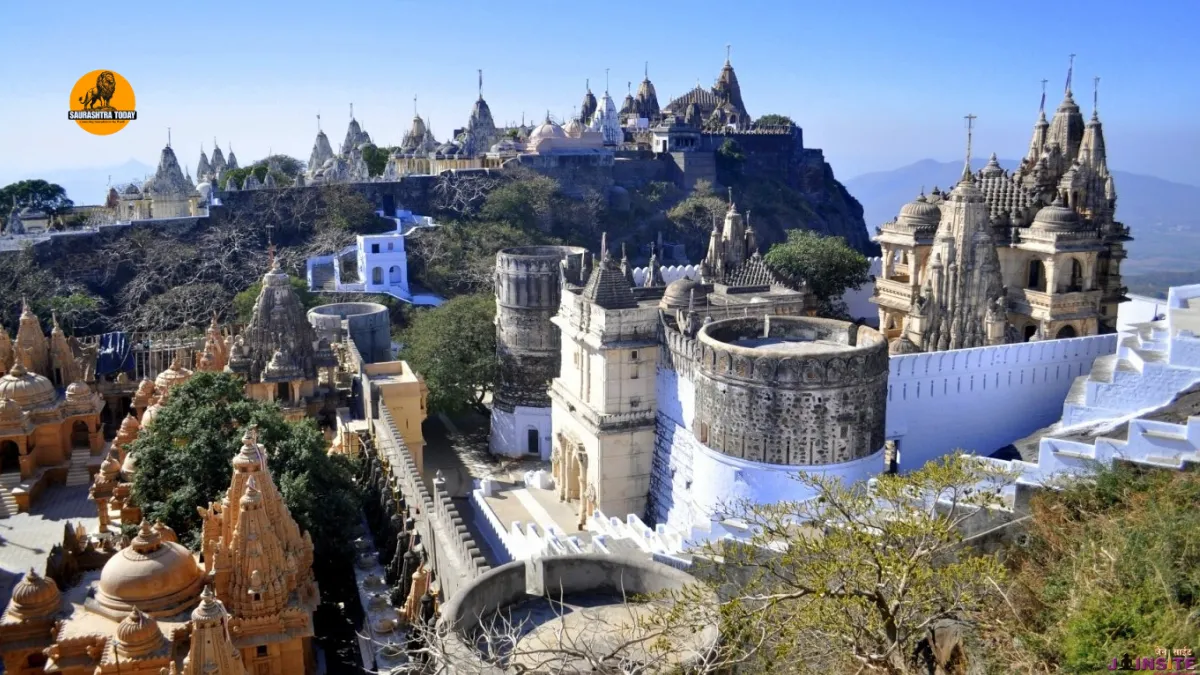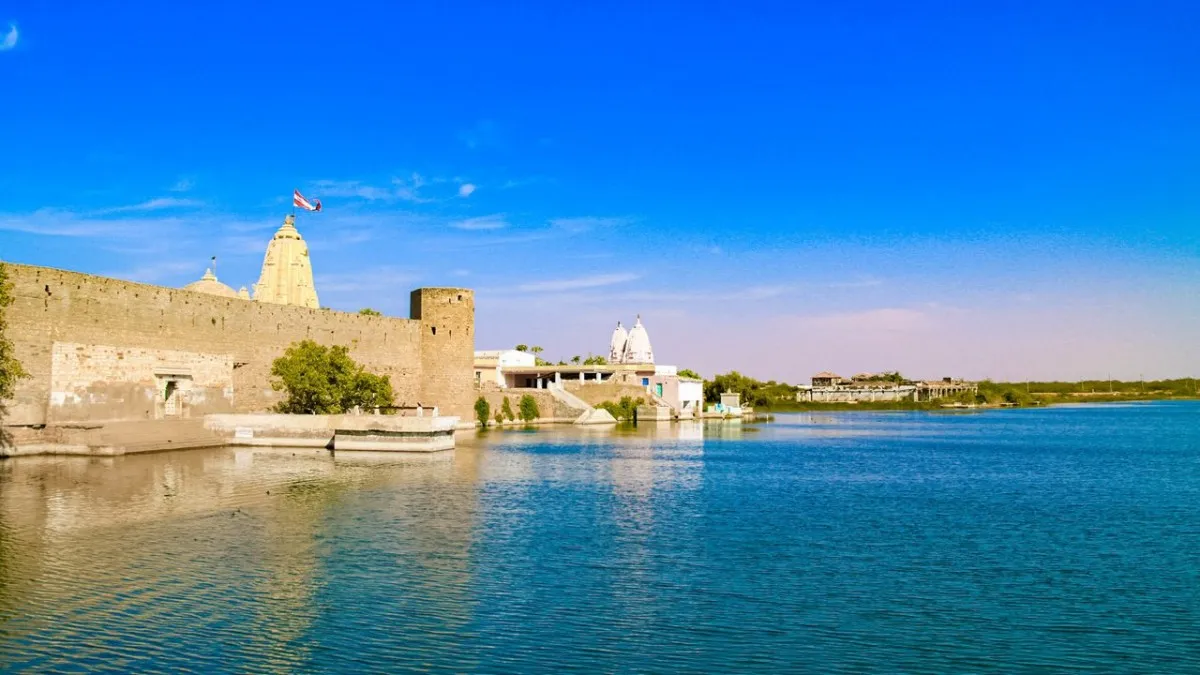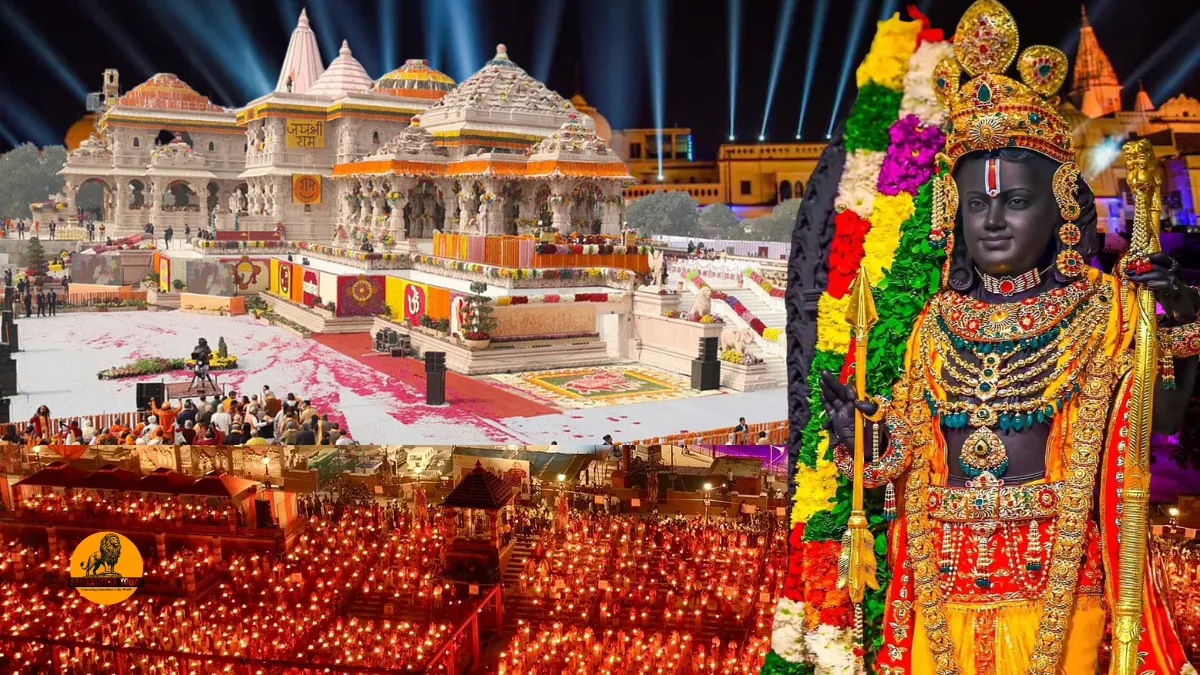The History of Shatrunjay Tirth is a tale of devotion, architecture, and spiritual grandeur that spans centuries. Nestled on the Shatrunjaya hills, near Palitana in Gujarat, this sacred site is revered as the most important pilgrimage, or tirtha, in Jainism. With over 1,300 exquisitely carved marble temples, Palitana stands as a testament to unwavering faith, architectural brilliance, and the spiritual dedication of countless generations.
Presiding Deity and Location
At the heart of the Shatrunjay Tirth stands the majestic temple dedicated to Lord Adinath (Rishabdeva), the first Tirthankar of Jainism. The presiding deity, Sri Adishwar Bhagwan, is a serene white-colored idol seated in a lotus posture, measuring 2.16 meters in height. Located just 6 kilometers from Palitana town (anciently known as Padaliptapur), this mountain shrine is accessible via a steep ascent of about 4 kilometers from the base of the hill.
The temple’s location on the Shatrunjaya hills, overlooking the sacred Shetrunji river, adds to the spiritual aura. Pilgrims often recount that every stone, every pebble (kankar), and every particle of soil here resonates with sanctity, symbolizing divine presence.
Architectural Marvels and Spiritual Significance
The Shatrunjay hills are home to an astonishing 3,364 steps leading devotees to the mountaintop temples, which rise approximately 600 meters above sea level. The site hosts 27,007 Tirthankara images, 3,507 Jain temples (Jinmandirs), and around 1,500 smaller shrines (paglas). Such a concentration of temples makes Palitana not only a center of spiritual worship but also a hub of architectural brilliance.
Palitana is often called the ultimate pilgrimage in Jainism, with devotees believing that even the gods desire to visit its sacred grounds. Pilgrims consider it essential to visit Palitana and Sammet Shikhar at least once in their lifetime. The divinity and grandeur of this pilgrimage have been celebrated across the world, attracting not only religious seekers but also tourists interested in spiritual and historical heritage.
The Devotion of Ascetics
Palitana is unique in hosting the largest congregation of Jain ascetics. These ascetics, who themselves lead a life of continuous pilgrimage and penance, add to the sanctity of the site. The city of temples is a living example of devotion, where every path leads to a shrine, every turn presents a new temple, and every journey up the hill becomes a spiritual exercise.
Prominent features include hundreds of dharmshalas (charitable boarding houses) for pilgrims and a 5 km long main road lined with temples and resting places. From the moment a devotee sets foot at the base of the hill, emotions surge, and gratitude fills the heart for being able to undertake this sacred journey.
The Majestic Temples and Toonks
Palitana is sometimes described as the “city of temples,” a fitting title for a site that houses 8,613 temples and nearly 33,000 idols. The temples adorn the twin summits of the hill, arranged systematically to resemble the letter ‘S’ from a distance. Among these, nine Toonks stand out for their historical and spiritual significance:
- Seth Narshi Keshav Toonk (1921 Vikram era) – Housing Tirthankar Shantinath, this temple is renowned for its intricate carvings.
- Khartarwasahi Toonk (Chaumukhji) – The northern summit’s tallest Toonk, featuring four-faced idols of Lord Aadinath.
- Chhepawasahi Toonk (1791 Vikram era) – Built by the Chheepa brothers, with Lord Rishabhdev as the principal deity.
- Saakarwasahi Toonk (1893 Vikram era) – Featuring four immortal Jineshwars: Rishbhanan, Chandranan, Varishen, and Vardhmaan.
- Heemwasahi Toonk (1886 Vikram era) – Devoted to Lord Ajitnath.
- Premwasahi Toonk (1843 Vikram era) – Dedicated to Lord Shree Rishabhdev.
- Balawasahi Toonk (1893 Vikram era) – Renovated by Bala Bhai, worshipping Lord Aadinath.
- Motishah Toonk (1893 Vikram era) – The largest Toonk, built by Seth Motishah, with Lord Shree Aadinath as the main deity.
- Adbhut Baba Temple – Featuring an 18-feet high lotus-seated idol of Lord Aadinath near Premwasahi Toonk.
Each Toonk holds unique artistic, historical, and spiritual significance, collectively representing centuries of devotion and craftsmanship. The temples showcase unparalleled Jain art, with intricate carvings, sculpted idols, and decorative motifs that continue to inspire scholars and devotees alike.
Pilgrimage Rituals and Spiritual Practices
Pilgrimage to Shatrunjay is not only about reverence but also about spiritual discipline. Devotees perform the Navanu Yatra, walking up the hill 99 times to honor Lord Rishabhdev. The site also hosts Varshee-tap, a year-long penance where fasting alternates with food consumption every other day, culminating in the auspicious ritual of Parna.
The pilgrimage begins at the base, with key temples such as Jaytaleti, where devotees collect sacred sand to smudge on their foreheads. As they ascend, they encounter numerous sacred spots including Kumarpal-Kund, Sala-Kund, Sooraj Kund, Bheem Kund, and Ishwar Kund, each holding historical and spiritual significance.
Historical Legacy
The History of Shatrunjay Tirth is traced back even before the third Kalp of Lord Rishabhdev’s era. The site was maintained and renovated by historic figures including Chakravarti Bharat (son of Lord Rishabhdev), Maharaja Sagar, Lord Shriram, and even the Pandavas. Sixteen notable restoration works were documented, ensuring the preservation of its grandeur.
The hill itself has multiple names mentioned in Jain scriptures, such as Pundarik Giri, Vimalachal, and Siddhachal, highlighting its revered status across centuries. The temples, Toonks, and dharmshalas are products of devotion by Shreshthis (wealthy businessmen) and Samantas (royal generals), showcasing the deep interconnection of faith, art, and philanthropy.
Also read: Palitana Shatrunjaya hill: A Spiritual Journey to Jainism’s Sacred Summit
Sacred Surroundings and Natural Beauty
The Shatrunjay river, flowing alongside the hill, is considered as sacred as the river Ganga. Pilgrims often bathe in its waters before ascending the hill. From the summit, the entire landscape of Palitana unfolds, with meticulously arranged temples on twin summits and lush greenery surrounding the ascent. The serene environment adds to the experience, combining nature’s beauty with spiritual elevation.
Notable Features and Temples
In addition to the main temples and Toonks, the site houses several significant landmarks:
- Samavasaran Temple – Features 108 idols of Bhagawan Parshvanath and life-sketch sculptures of Tirthankars.
- Aagam Temple, Jamboo Dweep, and Museum – Offering educational insight into Jain history and art.
- Rampol and Hathipol – Gateway temples with artistic stone elephants and intricate carvings.
- Navtunk and Chowmukhji – Important sites along the pilgrim’s route, symbolizing spiritual knowledge and devotion.
Special elements like the Paap-Punya window, through which devotees pass for symbolic cleansing, and the Ravan Tree, under which Lord Adinath performed penance, enrich the pilgrimage with spiritual stories and miraculous legends.
Festivals and Fairs
The Palitana temples host four major annual fairs:
- Kartik Poornima
- Falgun Shukla Trayodashi
- Chaitra Poornima
- Baishakh Shukla Tritiya
Additionally, Baishakh Krishna six marks the consecration of Lord Aadinath in the main Toonk. These fairs draw thousands of devotees from across India, showcasing a vibrant blend of faith, ritual, and community celebration.
Also read: Hutheesing Jain Temple: A Majestic Marble Marvel in Ahmedabad
Conclusion
The History of Shatrunjay Tirth is not merely a record of temples and idols; it is a chronicle of unwavering devotion, artistic excellence, and spiritual discipline. From the presiding deity Lord Adinath to the countless Toonks and sacred spots along the hill, Palitana stands as a beacon of Jain faith. Every stone, every step, and every ritual performed here symbolizes the pursuit of enlightenment, detachment, and transcendence.
For pilgrims and tourists alike, the journey to Shatrunjay is a journey of the soul. It is a place where faith meets artistry, devotion meets discipline, and history meets the present. The serene beauty, spiritual intensity, and historical legacy make Palitana not just a pilgrimage site but a living testament to Jainism’s eternal light. Truly, those who visit Shatrunjay Tirth experience a rare blessing, a connection with centuries of devotion, and a glimpse into the divine.



















